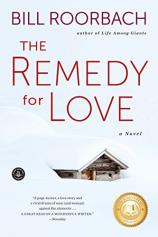Reading Group Guide
Discussion Questions
The Remedy for Love

1. A plot can sometimes be thought of as a cascade of events. Can you trace the elements of that cascade here? Which moments could be considered points of no return? Upon which elements does the story primarily turn?
2. Our protagonists meet in line at a grocery store, each with a basket of purchases that might or might not illuminate their characters. How do those purchases find their ways into the rest of the story? What role does food --- buying, cooking, serving, eating --- play in the novel?
3. Eric and Danielle seem ill suited for one another on the surface, yet as events peel away their defenses and their social strategies, an essential compatibility is revealed. Or is it? Do you think there’s a chance they will continue on beyond this adventure as a successful couple? Why or why not?
4. What did you expect from the story, and what did you hope for, and what might you change about the ending if it were yours to adjust?
5. THE REMEDY FOR LOVE is built in three parts. How do these divisions announce changes in the story? In the characters? In the reader’s understanding of both?
6. Something close to 100 percent of scientists agree that climate change is happening, is measurable, and is caused by human activities. One effect of climate change, already in place and predicted to worsen, is an increase in the number and severity of storms of all kinds, including winter storms. The reviewer for Newsday says that though THE REMEDY FOR LOVE “contains no references to global warming, it might be the first grown-up climate-change love story.” What does she mean?
7. Did you start out liking one of the two main characters more than the other? Did your allegiances shift? If there was a particular moment your feelings changed about the characters, when exactly was it?
8. Who is saving whom in this story? In what ways does each character need help? In what ways does each offer it?
9. THE REMEDY FOR LOVE is a portrait, in its way, of small-town New England life, though it takes place mostly in the confines of a small cabin. What role does the community of Woodchurch play in the story?
10. Could the cabin be thought of as a character?
11. Both Eric and Danielle are deeply mired in relationships far from their immediate plight. How important are the characters who remain offstage --- Alison and Jimmy, in particular --- and in what ways do they make themselves known in the story, even central to it?
12. “Man against Nature” is a common theme of literature. How does THE REMEDY FOR LOVE fit into that model? How does itsubvert it? To what extent is nature a character here?
13. What is the function of the beach Eric seems so intent on building; why does he spend so much time arranging his house, while Danielle waits on the porch?
14. The remedy for love, Thoreau has said, is “to love more.” How does that advice play out in the novel?
15. Some readers come to the end of THE REMEDY FOR LOVE and believe that one or the other character or both of them have died in the end, while other readers are equally certain they are both alive. What’s the case for either point of view, and to which do you subscribe?
The Remedy for Love
- Publication Date: June 30, 2015
- Genres: Fiction, Romance, Romantic Suspense, Suspense, Thriller
- Paperback: 336 pages
- Publisher: Algonquin Books
- ISBN-10: 1616204788
- ISBN-13: 9781616204785








